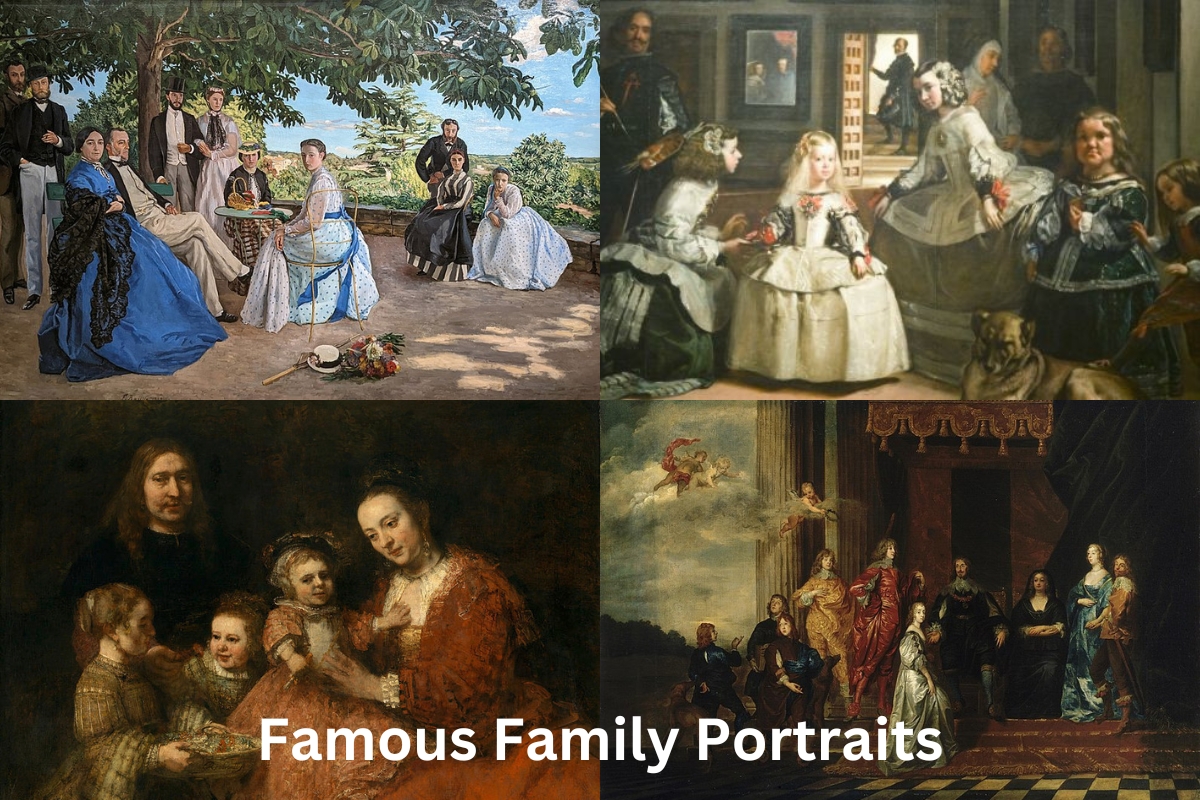Portraits of members of a family, such as grandparents, great-grandparents, great-great-grandchildren, aunts, uncles, and cousins, are depicted in family portrait paintings.
Paintings of loved ones let us feel a deeper connection to the past. Children will feel more invested in their own history if they are shown artwork of their family from different eras. They are aware of the forebears who contributed to making them who they are today.
Before the invention of photography, the family portrait painting was one of the few ways to visually record several generations in one place.
Below are some of the most famous family portraits ever created.
Famous Family Portraits
1. The Washington Family – Edward Savage
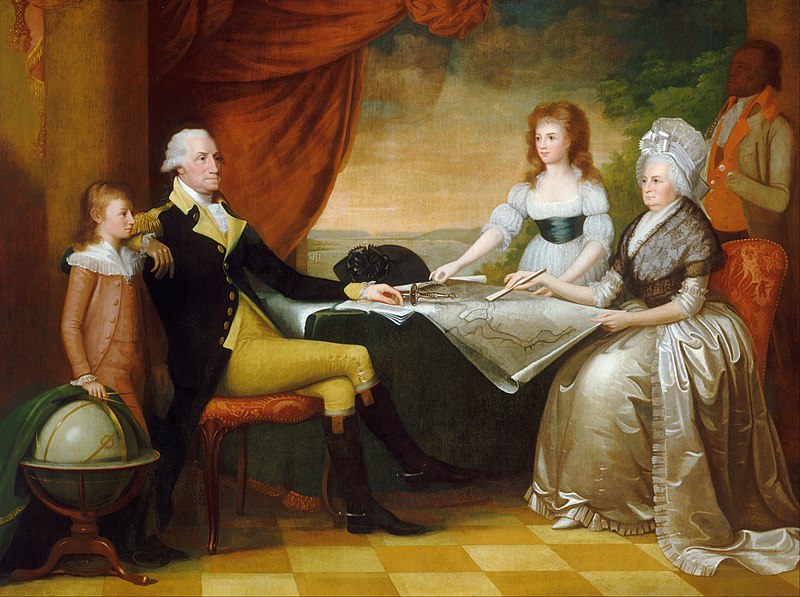
Life-size portrait by Edward Savage, The Washington Family depicts George Washington, Martha Washington, two of her grandkids, and an unnamed black servant, possibly an enslaved man.
The 7-by-9.3-foot painting is currently on display at the National Gallery of Art in Washington, D.C.
Savage started the oil painting in New York City in 1789–1790 based on life studies he had done of Washington early in his administration, and he finished it in Philadelphia in 1795–1796.
Starting in 1798, Savage began mass-producing prints, and by 1840, John Sartain was doing the same. Savage and Robert Wilkinson issued a color engraving in London in 1798, and a print of it can be seen in the holdings of the Library of Congress.
In the nineteenth century, the image gained widespread attention. Washington had four prints made of Savage’s etching, and hung one in the Mount Vernon dining room.
2. Las Meninas – Diego Velázquez
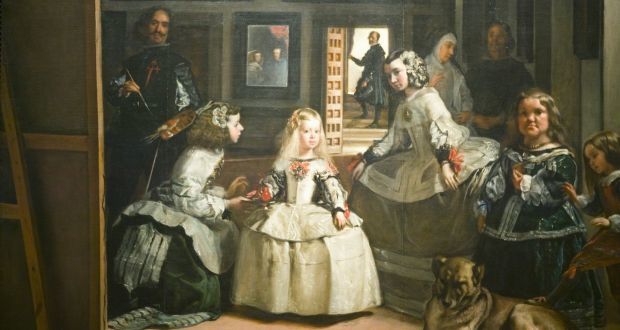
Las Meninas, one of the most groundbreaking works of art of its day, may not seem all that remarkable to a modern viewer.
For Diego Velazquez, painting Las Meninas in 1656 was a radical departure from his earlier, more conventional royal portraits.
There was a lot more order and hierarchy in the pictures of the day, which before would have only included members of the royal family.
But Las Meninas boldly deviates from the norm by include not just a nun, dwarf, and princess, but also the artist.
Velazquez was a palace chamberlain at the Spanish royal court at the time, a position that gave him more freedom than most artists of the time.
3. The Family Reunion – Frédéric Bazille
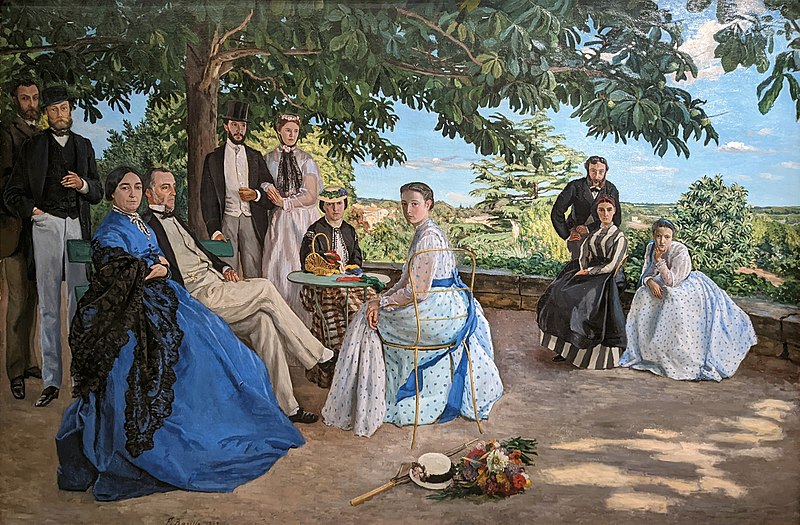
The Family Reunion, also known as Portraits of the Family, is a painting by French artist Frédéric Bazille that was completed in 1867. The Musée d’Orsay in Paris currently proudly displays it.
His immediate family, including himself (far left) and his parents (sitting) on the patio of their home in Méric, a little town not far from Montpellier, France.
On this sunny day, the party is sitting under the canopy of a huge tree, which casts dramatic shadows.
Bazille’s subjects are all motionless, looking at the viewer, giving his work the stilted feel of a wedding photograph, in contrast to Claude Monet’s painting Women in the Garden, which Bazille had recently purchased from the artist and in which the subjects are captured absorbed in their own activity.
Nevertheless, the Salon in 1868 chose this painting above several of Monet’s riskier ones and displayed it. The State Museums purchased it from the Bazille family in 1905.
4. Portrait of a Family – Rembrandt
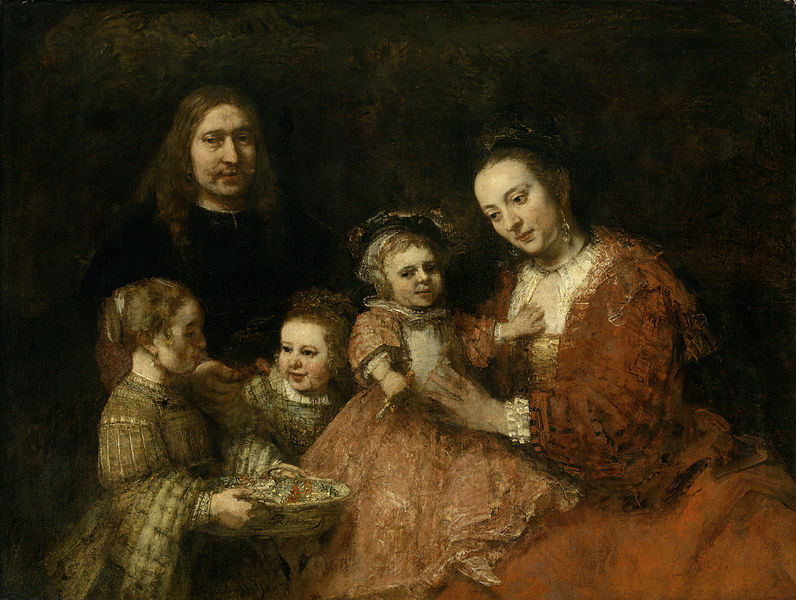
Family Portrait / The Brunswicks Rembrandt painted Portrait in 1668; it is housed in the Herzog Anton Ulrich-Museum in Braunschweig.
One of Rembrandt’s final works is this portrait of his own family. It’s undated, but it was likely created in his latter years, around 1668.
It’s painted in his characteristically aggressive, late style, with thick, gestural brushstrokes and a layered, textured surface achieved by employing both a palette knife and a brush.
Faces, on the other hand, show a more careful buildup of layers of paint, with Rembrandt using small brushes to illustrate the nuances of the features.
Just like many other recent works, this one focuses on the fundamentals. The mother’s skirt is a flat field of warm orange paint, and the garden setting is described in the barest of terms.
5. The Potato Eaters – Vincent van Gogh
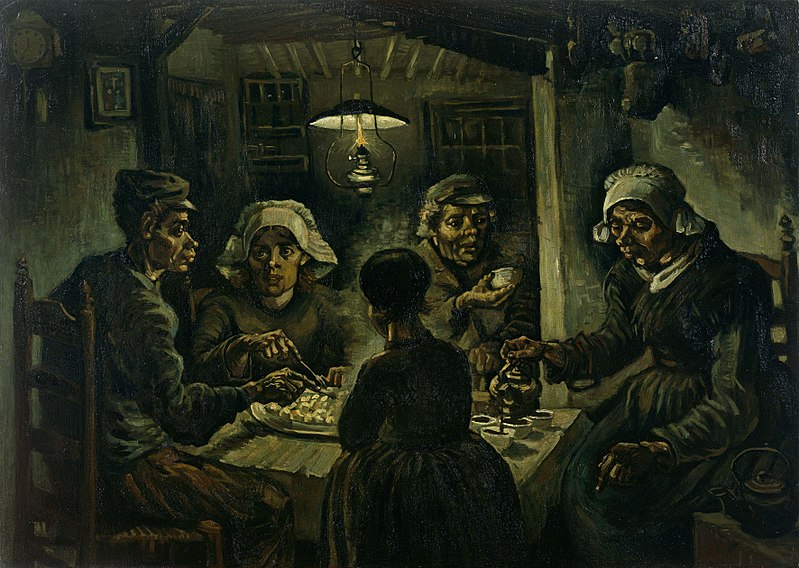
In April of 1885, a Dutch artist van Gogh finished an oil painting called The Potato Eaters. The artist also made several lithographs from his oil drawing, which may be seen at the Kröller-Müller Museum in Otterlo.
An ambitious new artist sets out to make a name for himself with The Potato Eaters. As a means of honing his skills, he would produce a large number of preliminary sketches and lithographs before ever attempting a figure painting.
It takes a lot of skill to paint five people sitting in a dark room lit only by an oil light.
Between April 13 and the beginning of May, Van Gogh completed the “real” painting. He opted for a larger canvas, which he titled The Potato Eaters.
In contrast to the other oil and charcoal sketches, this one was painted’mostly from memory,’ making it an even more impressive demonstration of the artist’s skill.
6. Philip Herbert, 4th Earl of Pembroke, with his Family – Anthony van Dyck
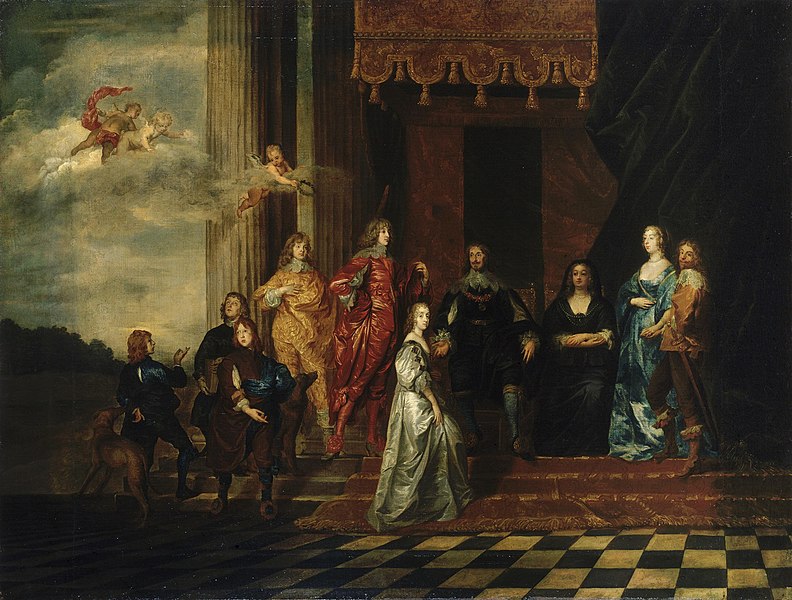
During the reigns of James I and Charles I, Philip Herbert, the 4th Earl of Pembroke and the 1st Earl of Montgomery, was an influential member of the English aristocracy and government.
Pembroke enjoyed art and was a part of the Whitehall group of painters. He was an avid art collector and supported artists like Anthony van Dyck. Charles I also had a passion for art.
Lady Mary Villiers, the future wife of Lord Charles Herbert, and Philip Herbert, 4th Earl of Pembroke and 1st Earl of Montgomery, with Lady Anne Clifford, 14th Baroness de Clifford, and their surviving children from Philip’s previous marriage.
7. Charles IV of Spain and His Family – Francisco Goya
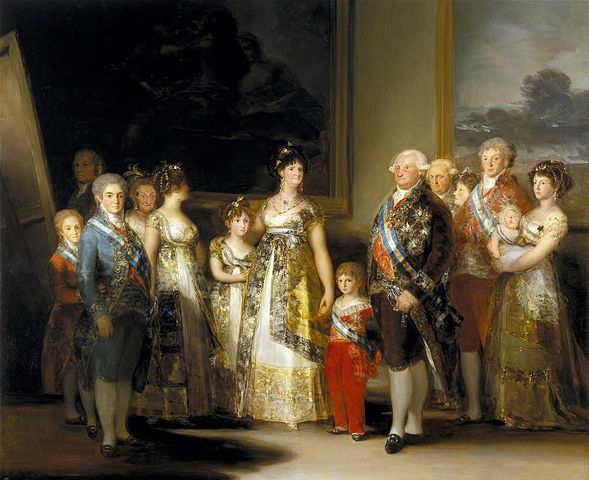
Charles IV of Spain and His Family, by Francisco Goya, is an oil on canvas depiction of the monarch and his family. Soon after accepting his position as the royal family’s First Chamber Painter in 1800, he began working on the painting, which he completed in the summer of 1801.
King Charles IV of Spain and his family are depicted in life size, wearing lavish garments and jewelry. The artwork features King Charles IV and his family, including his wife Maria Luisa of Parma, their children, and other relatives.
The family is dripping with diamonds and sashes bearing the order of Charles III, and they are all dressed to the nines in the latest styles.
The royal subjects pose for the artist, who can be seen at his easel to the left of the panel, in this picture that was influenced by Velázquez’s Las Meninas and Louis-Michel van Loo’s Portrait of Felipe V and His Family (1743).
Much like in Las Meninas, the artist is seen at work, but the viewer can only see the back of the canvas.
Goya completed the group portrait a year after he succeeded Diego Velázquez as first court painter, Spain’s greatest artistic honor.
8. The Virgin and Child with Saint Anne – Leonardo da Vinci
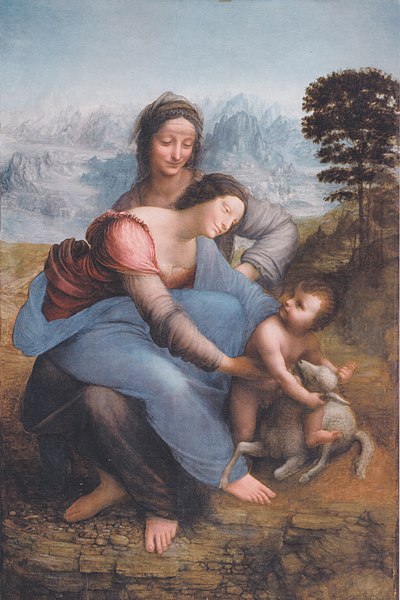
An unfinished oil painting by Leonardo da Vinci, The Virgin and Child with Saint Anne dates to some time during the High Renaissance, between 1501 and 1519.
It shows Mary, the Virgin Anne, and a baby Jesus, who is being held by Mary and her mother, Anne. The Virgin Mary tries to restrain Christ as he struggles with a sacrifice goat representing his crucifixion.
The work, which was commissioned as the high altarpiece for Florence’s Church of Santissima Annunziata, was based on a subject that had long captivated Leonardo.
9. Holy Family under an Oak Tree – Giulio Romano
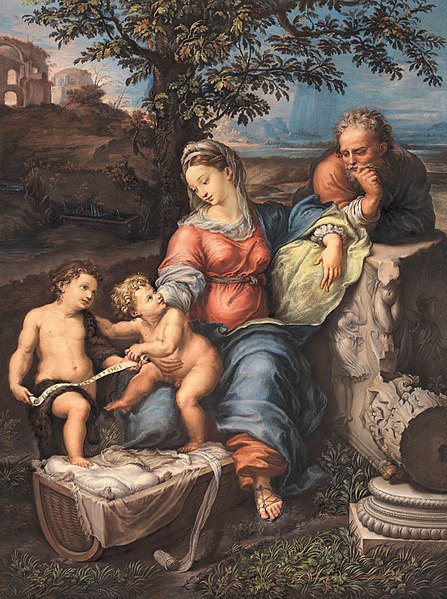
Giulio Romano’s oil on panel work Holy Family under an Oak Tree, also known as Madonna of the Oak Tree, was based on a composition or underdrawing by Raphael. It is now housed in the Prado in Madrid.
Its aesthetic affinity with other works by the two artists at the same time, such as La Perla, allows us to place it in the period around 1518. (Prado). A valley suggestive of the Tiber can be seen in the distance, while a ruin on a hill to the left is reminiscent of either the Basilica of Maxentius or the Baths of Caracalla.
The many copies that have been preserved testify to its widespread acclaim; some can be found in Pesaro, Bologna, the Hermitage Museum, the Royal Collection at Hampton Court Palace, and the Hague, among other locations.
Girolamo Siciolante da Sermoneta is credited with creating another Madonna and Child at the Galleria Palatina in Florence, which is known as Madonna of the Lizard (Madonna della Lucertola) because to the inclusion of a lizard on the column fragment in the right foreground.
10. Christ in the House of His Parents – John Everett Millais
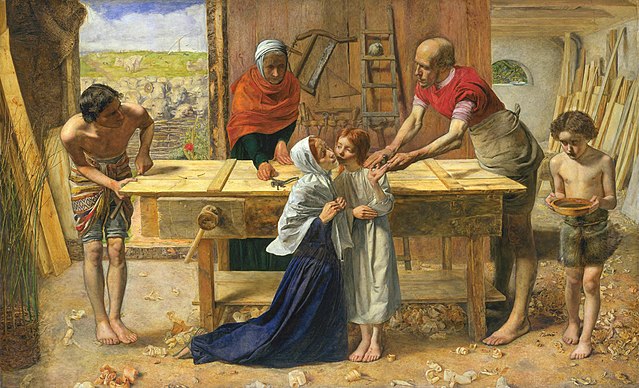
John Everett Millais’s painting Christ at the House of His Parents (1849-50) shows the Holy Family in Saint Joseph’s workshop. The artwork caused controversy when it was first displayed, leading to multiple negative reviews, including one written by Charles Dickens.
It was a significant addition to the discussion of Realism in the arts and brought the Pre-Raphaelite Brotherhood to the forefront of the public’s awareness.
The artwork caused controversy when it was first presented since it so accurately depicted a carpenter’s workplace, especially the dirt and debris on the floor. The traditional portrayal of Jesus, his family, and his disciples wearing Roman togas stood in sharp contrast to this.
Negative reviews helped spread awareness of the Pre-Raphaelite movement and spurred a debate over the relationship between modernism, realism, and medievalism in art.
John Ruskin, a critic, defended Millais in a letter to the newspaper and in a lecture titled “Pre-Raphaelitism,” despite his distaste for the painting. The painting’s use of symbolic realism to blend composition and subject with careful observation inspired a broader movement.

